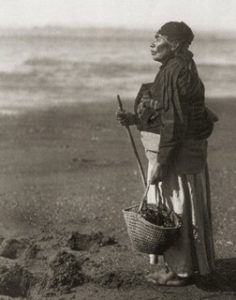
A Chinook woman
Because the Chinook lived so far north and west, they didn’t have any contact with European invaders in the 1500s or 1600s AD. So we don’t know much about what the Chinook were doing during these two centuries.
But in 1792, the Chinook who lived along the Pacific coast met the American sea captain Robert Gray, who landed at Astoria and traded blankets, sheets of copper, nails, axes and knives to the Chinook chief Polack and his people for furs. From then on, more and more ships came to buy furs from the Chinook. Sometimes they also bought people to enslave, who were usually prisoners of war captured by the Chinook from their neighbors. Sometimes they sold enslaved African-Americans to Chinook people. Many times United States traders sold blue glass beads, which Chinook people liked a lot. United States traders also sold potatoes to Chinook people, who liked them better than their own wapatos.
In 1805, the United States explorers Lewis and Clark came down the Columbia river in canoes and set up a fort on the Pacific coast called Fort Clatsop, named after the Clatsop people who were part of the Chinook people. Lewis and Clark left some men at Fort Clatsop, and the Chinook began to trade with them. Soon after that, in 1811, the United States trader John Jacob Astor founded the town of Astoria as a trading post with the Chinook for furs.
Once the Chinook began to trade with the United States, however, they began to catch European diseases. Between 1800 and 1830, many Chinook people died of smallpox, malaria, and other European diseases. In 1830, nearly all of the surviving Multnomah group died of malaria. By the time settlers from the United States arrived on the Oregon Trail about 1850, there were not very many Chinook people left to oppose them, and the settlers soon took over. In 1851, the Clatsop people surrendered almost all of their land to the United States government.
More Pacific Northwest people: the Nez Perce
The Paiute
The Shoshone
Californian Native people
More about Lewis and Clark
Bibliography and further reading about Chinook history: